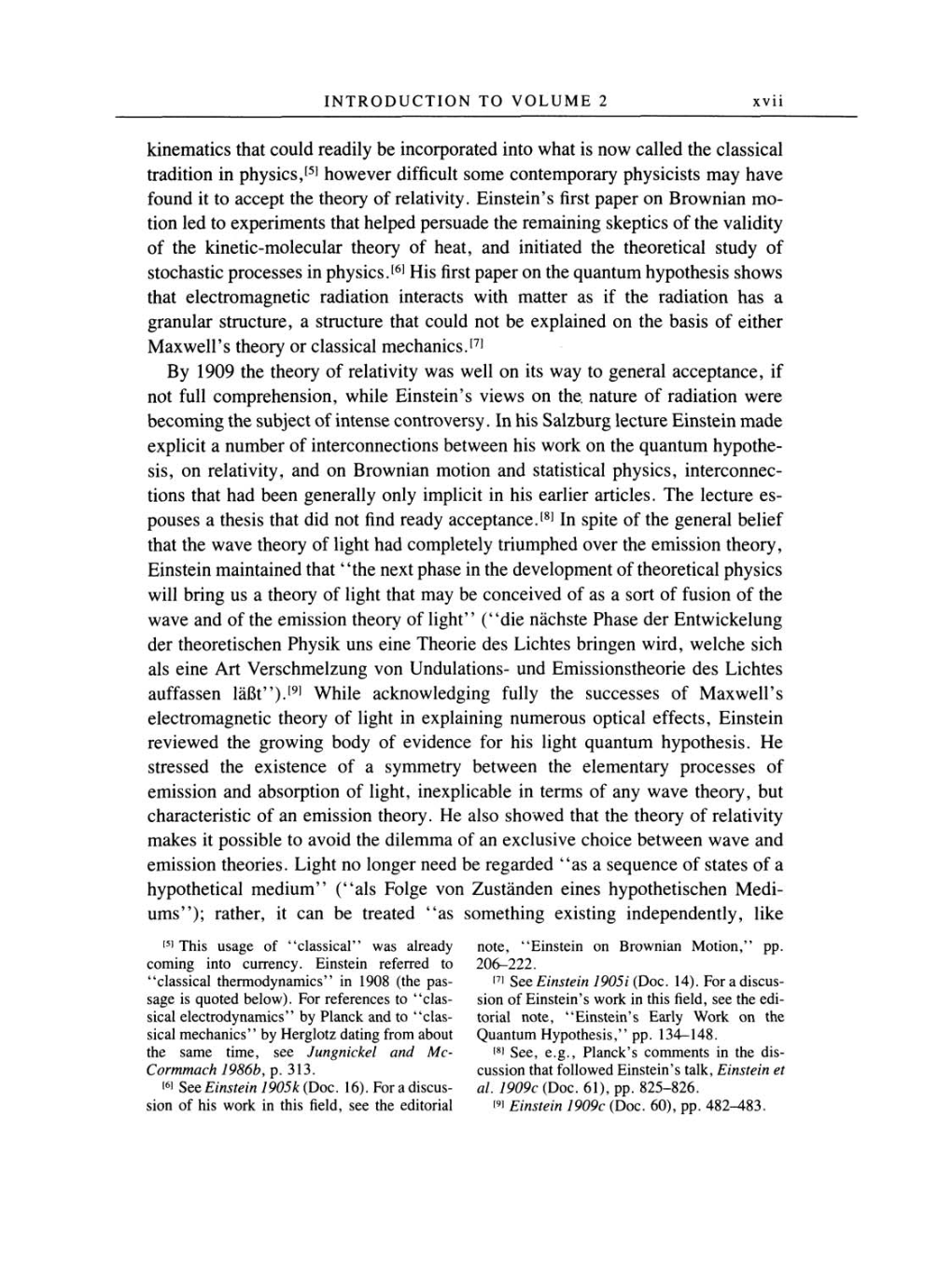INTRODUCTION
TO VOLUME
2
xvii
kinematics that could
readily
be
incorporated
into what is
now
called the
classical
tradition in
physics,[5]
however
difficult
some contemporary physicists
may
have
found
it to
accept
the
theory
of
relativity.
Einstein's
first
paper
on
Brownian
mo-
tion led to
experiments
that
helped persuade
the
remaining skeptics
of
the
validity
of
the kinetic-molecular
theory
of
heat,
and initiated the theoretical
study
of
stochastic
processes
in
physics.[6]
His
first
paper
on
the
quantum hypothesis
shows
that
electromagnetic
radiation interacts with matter
as
if the
radiation
has
a
granular structure,
a
structure that could not be
explained on
the basis
of
either
Maxwell's
theory or
classical mechanics.[7]
By
1909 the
theory
of
relativity was
well
on
its
way
to
general acceptance,
if
not full
comprehension,
while
Einstein's
views
on
the nature
of radiation
were
becoming
the
subject
of
intense
controversy.
In his
Salzburg
lecture Einstein made
explicit a
number
of
interconnections between his work
on
the
quantum hypothe-
sis,
on relativity,
and
on
Brownian motion and statistical
physics,
interconnec-
tions that had been
generally only implicit
in his earlier articles. The lecture
es-
pouses a
thesis that did
not
find
ready acceptance.[8]
In
spite
of
the
general
belief
that the
wave theory
of
light
had
completely triumphed over
the emission
theory,
Einstein maintained
that
"the
next
phase
in the
development
of
theoretical
physics
will
bring us a
theory
of
light
that
may
be conceived
of
as a
sort
of
fusion
of
the
wave
and
of
the
emission
theory
of
light"
("die nächste Phase
der
Entwickelung
der theoretischen
Physik
uns
eine Theorie des Lichtes
bringen
wird,
welche sich
als eine Art
Verschmelzung von
Undulations- und Emissionstheorie
des Lichtes
auffassen
läßt").[9]
While
acknowledging
fully
the
successes
of
Maxwell's
electromagnetic
theory
of
light
in
explaining
numerous
optical
effects,
Einstein
reviewed the
growing body
of
evidence for his
light quantum
hypothesis.
He
stressed the existence
of
a
symmetry
between the
elementary
processes
of
emission and
absorption
of
light, inexplicable
in terms
of
any wave
theory,
but
characteristic
of
an
emission
theory.
He also showed that the
theory
of
relativity
makes
it
possible
to avoid the dilemma
of
an
exclusive choice
between
wave
and
emission theories.
Light no longer
need be
regarded
"as
a sequence
of
states
of
a
hypothetical
medium"
("als
Folge
von
Zuständen eines
hypothetischen
Medi-
ums"); rather, it
can
be treated
"as
something existing
independently,
like
[5]
This
usage
of
"classical"
was already
coming
into
currency.
Einstein referred
to
"classical
thermodynamics"
in 1908
(the
pas-
sage
is
quoted
below).
For references to
"clas-
sical
electrodynamics"
by
Planck and
to
"clas-
sical
mechanics"
by Herglotz dating
from about
the
same
time,
see
Jungnickel
and
Mc-
Cormmach
1986b,
p.
313.
[6]
See
Einstein
1905k
(Doc. 16).
For
a
discus-
sion
of
his work in this
field, see
the editorial
note,
"Einstein
on
Brownian Motion,"
pp.
206-222.
[7]
See Einstein 1905i
(Doc. 14).
For
a
discus-
sion
of Einstein's
work in this
field, see
the edi-
torial note,
"Einstein's
Early
Work
on
the
Quantum
Hypothesis,"
pp.
134-148.
[8]
See, e.g.,
Planck's
comments
in the dis-
cussion that followed
Einstein's
talk,
Einstein
et
al. 1909c
(Doc.
61), pp.
825-826.
[9]
Einstein 1909c
(Doc.
60),
pp.
482-483.
